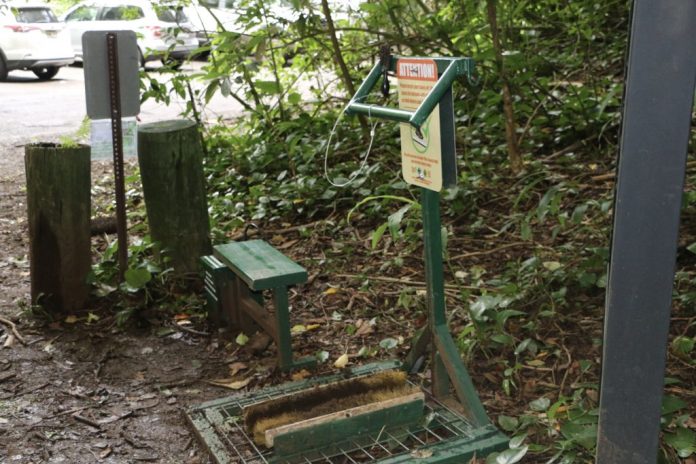[ad_1]
Hawaiian Electric Company has stepped up to help reduce the spread of the Rapid ‘Ōhi‘a Death disease on Oʻahu through the design, fabrication, and installation of a new style of boot brush station for trailheads.
Sean Moura, Hawaiian Electric wildlife biologist, took an existing boot brush design and modified it to be more inviting and user-friendly, according to an update from the state Department of Land and Natural Resources.
In collaboration with the DLNR Division of Forestry and Wildlife, the concept was to fine tune the design and coordinate the fabrication of six prototype stations by the utility’s Electrical & Welding Services personnel.
These custom-built boot brush stations are the first of their kind in Hawai‘i to include a separate dispenser for sterilizing spray and a bench so users can sit down and spray the bottoms and sides of their shoes comfortably.

Plant pathologist Dr. Lisa Keith and her team at the USDA Agricultural Research Service in Hilo found that 70% isopropyl alcohol kills the pathogens that cause ROD.
“We recommend using a boot brush before and after hiking to remove soil that can contain the ROD pathogens and then spraying shoe soles with isopropyl alcohol to kill any remaining fungal spores,” said Keith. “We collected soil samples from 34 boot brush stations on Hawai‘i island, and we found that 28 of the stations had the ROD pathogens. Even though just a handful of those samples were still viable, this limited study shows that the ROD pathogens do move around on shoes.”
“Our environmental stewardship efforts at Hawaiian Electric includes protecting native endemic species, especially in areas where our utility infrastructure might intersect with their habitats,” said Karin Kimura, director of the HECO Environmental Division. “Working together, we can help reduce the spread of invasive species and ROD, and we’re glad to be a part of the effort to protect Oʻahu’s native forests.”
Signage for the boot brush stations was produced through a grant from the Hauʻoli Mau Loa Foundation. DOFAW staff have installed the stations at these six trailheads around Oʻahu: Hawai‘i Loa, Wiliwilinui, Manana, Waimano, Moanalua, and Aiea Loop. The first boot brush station was installed at the Kamana Nui and Kamana Iki Valleys in Moanalua at the end of March.
“Boot brush stations are not a new idea; however, our expanded design with a modified handlebar and an integrated seating bench is meant to encourage hikers to use it,” Moura said. He and staff from the Environmental Division will visit the trailheads quarterly over the next five years and replace any boot brushes that are worn out, while DOFAW will be responsible for maintaining the integrity of the stations.
DLNR Chairperson Suzanne Case thanked Hawaiian Electric and Hau’oli Mau Loa Foundation for their partnership and being good stewards of the forest. “With many natural areas seeing a record number of visitors, and with the resumption of interisland travel, DLNR and its partners remind all forest users to clean their shoes, gear, and vehicles of any soil, and spray with a 70% alcohol solution–before and after visiting the forest.”
ROD is caused by two related non-native fungal pathogens. These pathogens have killed over a million trees spread over more than 185,000 acres of forest on Hawai‘i Island, and both pathogens are present on Kauaʻi in limited areas.
On O‘ahu, there have been five ‘ōhiʻa trees infected with the slower-acting pathogen that causes ROD, while there have been no detections of the more aggressive ROD pathogen.
To date, there are no known ROD trees present on Molokaʻi, Lānaʻi, and the only ROD positive tree on Maui was discovered and destroyed in 2018. Funds provided by the Hawai‘i Legislature and by USDA continue to support aerial and ground-based surveys and sampling for ROD in forests statewide, and the USDA ARS in Hilo continues to process samples to determine the presence or absence of the ROD pathogens.
[ad_2]
